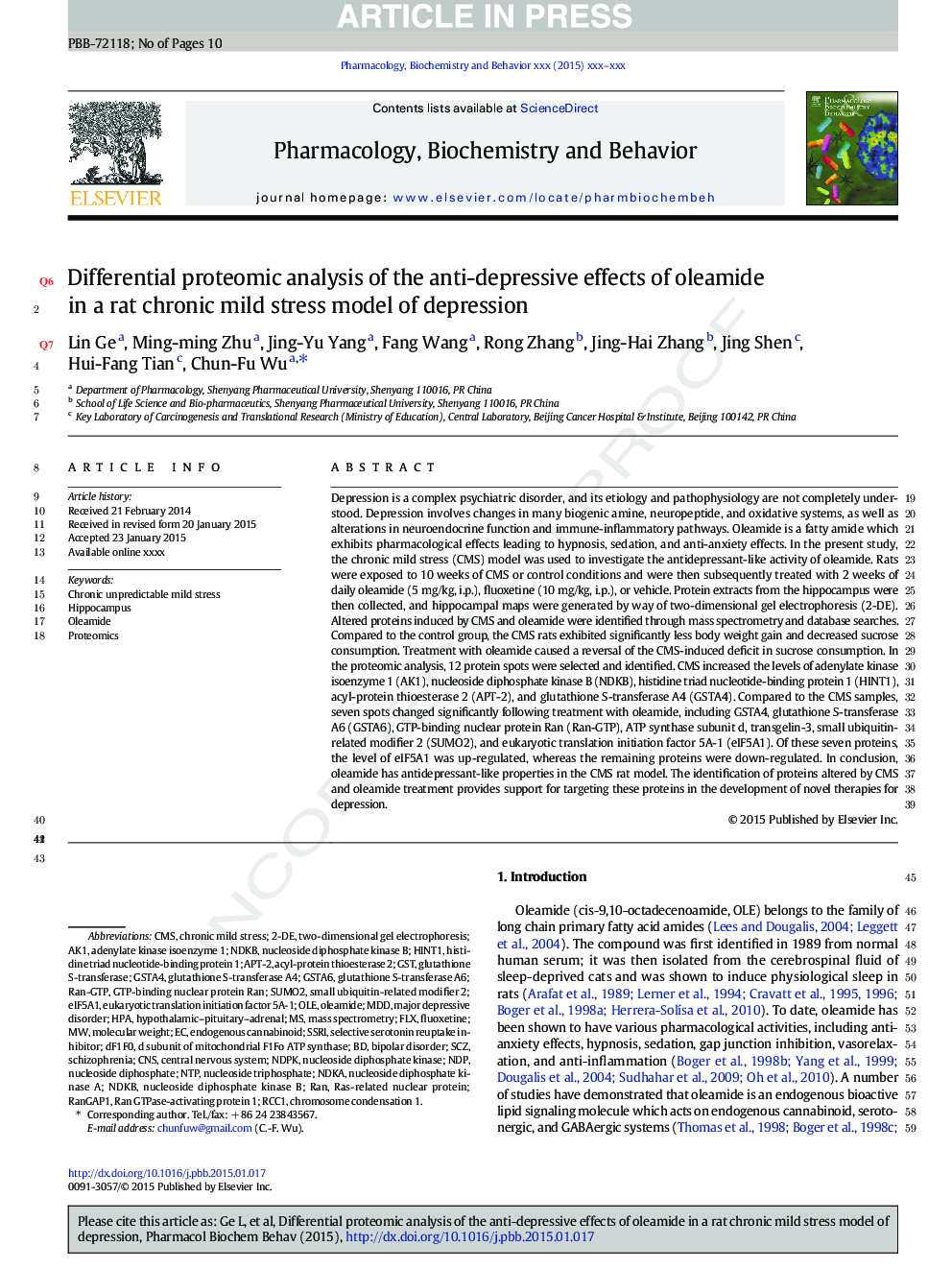| Article ID | Journal | Published Year | Pages | File Type |
|---|---|---|---|---|
| 8350676 | Pharmacology Biochemistry and Behavior | 2015 | 10 Pages |
Abstract
Depression is a complex psychiatric disorder, and its etiology and pathophysiology are not completely understood. Depression involves changes in many biogenic amine, neuropeptide, and oxidative systems, as well as alterations in neuroendocrine function and immune-inflammatory pathways. Oleamide is a fatty amide which exhibits pharmacological effects leading to hypnosis, sedation, and anti-anxiety effects. In the present study, the chronic mild stress (CMS) model was used to investigate the antidepressant-like activity of oleamide. Rats were exposed to 10Â weeks of CMS or control conditions and were then subsequently treated with 2Â weeks of daily oleamide (5Â mg/kg, i.p.), fluoxetine (10Â mg/kg, i.p.), or vehicle. Protein extracts from the hippocampus were then collected, and hippocampal maps were generated by way of two-dimensional gel electrophoresis (2-DE). Altered proteins induced by CMS and oleamide were identified through mass spectrometry and database searches. Compared to the control group, the CMS rats exhibited significantly less body weight gain and decreased sucrose consumption. Treatment with oleamide caused a reversal of the CMS-induced deficit in sucrose consumption. In the proteomic analysis, 12 protein spots were selected and identified. CMS increased the levels of adenylate kinase isoenzyme 1 (AK1), nucleoside diphosphate kinase B (NDKB), histidine triad nucleotide-binding protein 1 (HINT1), acyl-protein thioesterase 2 (APT-2), and glutathione S-transferase A4 (GSTA4). Compared to the CMS samples, seven spots changed significantly following treatment with oleamide, including GSTA4, glutathione S-transferase A6 (GSTA6), GTP-binding nuclear protein Ran (Ran-GTP), ATP synthase subunit d, transgelin-3, small ubiquitin-related modifier 2 (SUMO2), and eukaryotic translation initiation factor 5A-1 (eIF5A1). Of these seven proteins, the level of eIF5A1 was up-regulated, whereas the remaining proteins were down-regulated. In conclusion, oleamide has antidepressant-like properties in the CMS rat model. The identification of proteins altered by CMS and oleamide treatment provides support for targeting these proteins in the development of novel therapies for depression.
Keywords
NDKBCMSFLXOLEHINT1NDPKRCC12-DEMDDSUMO2Ran-GTPNDPGSTAK1Nucleoside diphosphate kinase ANTPRanGAP1Ras-related nuclear proteingsta4SCZMajor depressive disorderbipolar disorderchronic mild stressSchizophreniatwo-dimensional gel electrophoresisOleamideCNSNucleoside diphosphate kinaseNucleoside diphosphatecentral nervous systemRånMass spectrometryFluoxetineSelective serotonin reuptake inhibitorSSRIHPAnucleoside triphosphatehypothalamic–pituitary–adrenalHippocampusMolecular weightProteomicsEndogenous cannabinoidglutathione S-transferase
Related Topics
Life Sciences
Biochemistry, Genetics and Molecular Biology
Biochemistry
Authors
Lin Ge, Ming-ming Zhu, Jing-Yu Yang, Fang Wang, Rong Zhang, Jing-Hai Zhang, Jing Shen, Hui-Fang Tian, Chun-Fu Wu,
